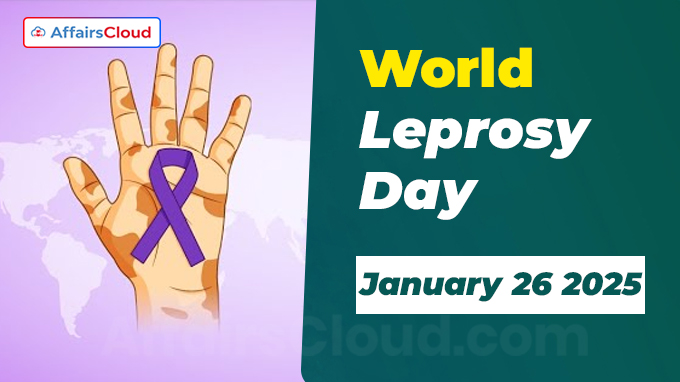 World Leprosy Day (WLD) is observed annually on the last Sunday of January across the globe to raise awareness about leprosy and to celebrate the resilience of those affected by the disease, combat stigma and discrimination. The day also serves as a reminder to eradicate leprosy and improve the lives of those impacted by it..
World Leprosy Day (WLD) is observed annually on the last Sunday of January across the globe to raise awareness about leprosy and to celebrate the resilience of those affected by the disease, combat stigma and discrimination. The day also serves as a reminder to eradicate leprosy and improve the lives of those impacted by it..
- 26 January 2025 marks the 72nd observance of the WLD.
- In 2024, WLF was observed on 28 January and in 2026, WLD will be observed on 25th January.
Theme:
The theme for WLD 2025 is “Unite. Act. Eliminate.” which highlights the need to urge governments, non-governmental organizations (NGO’s), and individuals to work together and eliminate the disease & its associated stigma.
Note: In India, WLD is observed on January 30 every year, coinciding with the death anniversary (January 30 1948) of Mahatma Gandhi in recognition of his legacy, social justice and the welfare of people affected by leprosy.
Background:
i.WLD was founded in 1954 by Raoul Follereau, a French philanthropist and writer to raise global awareness about leprosy.
- The first-ever WLD was observed on 31st January (Last Sunday of January)1954.
ii.The day was chosen to coincide with the Feast of Saint Lazarus, the biblical figure who is associated with leprosy in the Christian tradition.
iii.Since then, WLD was observed annually and was recognised by the World Health Organisation (WHO).
Significance:
i.2025 also commemorates the 152nd anniversary of the discovery of Mycobacterium leprae (M. leprae), the bacterium that causes leprosy.
ii.The bacterium was discovered by Norwegian physician Gerhard Armauer Hansen on February 28, 1873.
About Leprosy:
i.Leprosy, also known as Hansen’s disease, is one of the oldest diseases which was named after Norwegian physician Gerhard Henrik Armauer Hansen, who proved that leprosy was not inherited, but was actually caused by bacteria.
- It is a chronic condition caused by the bacterium Mycobacterium leprae, which primarily affects the skin, peripheral nerves, eyes, and upper respiratory tract.
ii.The disease has a long incubation period, often taking 5 to 20 years for symptoms to appear.
iii.Transmission: Leprosy spreads through droplets from the nose and mouth during close contact with untreated individuals.
iv.Treatable and Curable: Leprosy is curable with Multidrug Therapy (MDT), which has been provided free of charge by the WHO since 1995.
Points to Note:
i.India has achieved the elimination of leprosy as a public health problem as per WHO criteria of less than 1 case per 10,000 population at the National level in 2005.
ii.According to WHO, Leprosy is a Neglected Tropical Disease (NTD) that continues to affect over 120 countries worldwide, with more than 200,000 new cases reported annually.
About World Health Organization (WHO):
Director-General (DG)-Dr.Tedros Adhanom Ghebreyesus
Headquarters- Geneva, Switzerland
Established- April 7, 1948




